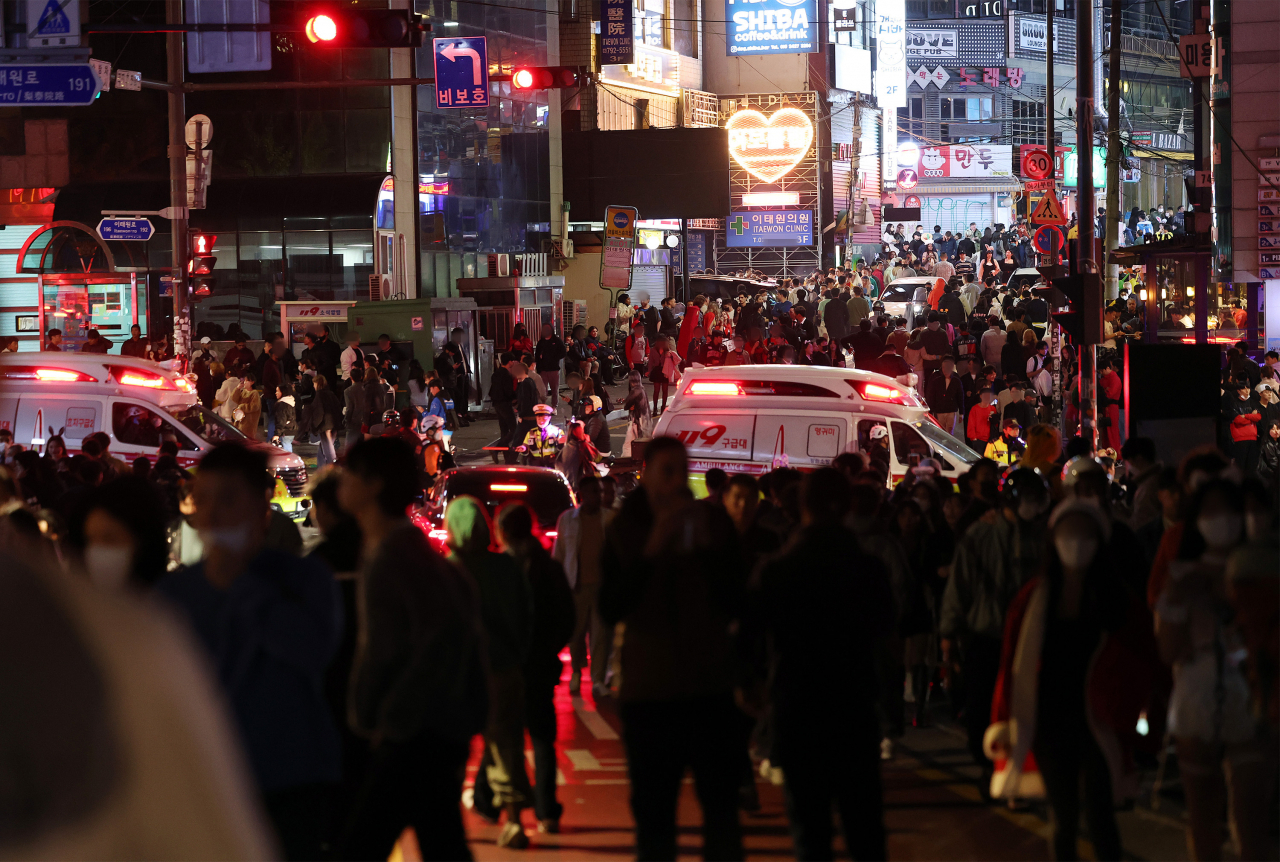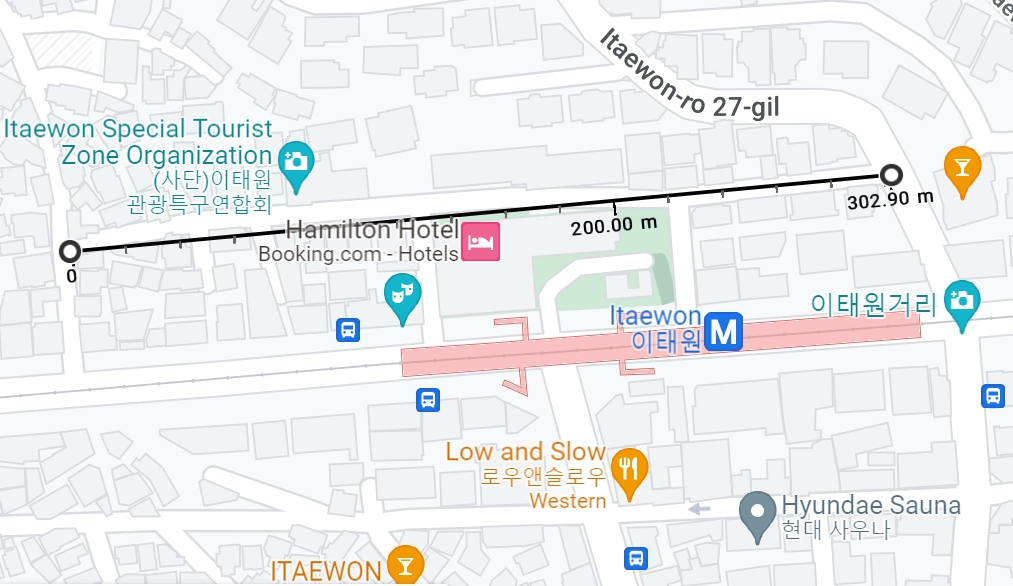
South Koreans are searching for answers after 154 lives perished Saturday in what was meant to be a fun Halloween night out in Itaewon.
As the authorities, the media and the public scramble to figure out what went wrong, here are some of the factors that may have been behind the deadly crowd surge in Seoul’s busy nightlife district.
1. Halloween: an event without an organizing body
Halloween, though originated in the West, is a popular celebration among young people in South Korea. Known for attracting party-goers from all backgrounds, Itaewon is the go-to place to celebrate the night for many. But unlike official events, there is no organizing body for the annual festival.
When Itaewon Global Village Festival was held earlier this month -- an annual event run by the Itaewon Special Tourist Zone Organization with the support of the Seoul city government and Yongsan District -- the main road stretching across the neighborhood was closed off.
On Sunday following the tragic crowd surge, the four-lane road was closed and a sign was put up by Yongsan Police Station directing drivers to take a detour.
“Since Halloween is American culture and there are many foreigners who come to Itaewon, businesses hold events of their own volition. Closing off traffic for Halloween has never been considered in the past,” said one official at Yongsan District Office.
Discussions were held prior to Saturday on matters such as food safety, COVID and street cleaning, but not on disaster and safety control, the official explained.
“We haven’t introduced Halloween-specific measures before other than to deal with the pandemic.
According to the Act on the Management of Disasters and Safety, those who wish to host a local festival with an attendance of over 1,000 or more people should draft a plan and take necessary action for safety management and inform the local authorities.
But with no organizing body for the celebration, it remains unclear who can be held legally accountable for this Saturday’s tragic event.
Against this backdrop, President Yoon Suk-yeol said Monday a safety management system will be established for events without an organizing body.
2. Lack of police presence and crowd control
According to police, 137 police officers were deployed in Itaewon on Saturday night. When asked whether there was enough police presence, Yoon Hee-keun, new head of the National Police Agency, said on Monday it was “difficult” to give a definite answer.
Multiple eyewitness accounts say there was little police presence to control the crowd. Viral clips on social media show people struggling to move quickly.
In a briefing on Sunday, Lee Sang min, Minister of Interior and Safety, said he understood that deploying police officers or firefighters in advance could not have “solved the problem.”
But Professor Choi Don-mook at the department of fire engineering at Gachon University told The Korea Herald there were several ways to respond to a growing crowd.
“When there are this many people, traffic must be closed off. Even if the turnout grew unexpectedly, (the authorities) could have checked CCTVs or even use drones and introduce one way traffic if necessary,” he said.
Minister Lee’s remark has also been criticized by the Lawyers for a Democratic Society, better known as Minbyun, as potentially downplaying the government’s safety management responsibility.
In a viral TikTok, Nathan Taverniti, an Australian survivor who survived the deadly crowd crush, said there was a “lack of planning police force and emergency services.”
“You know how many people were going to that event. Why were you not prepared?” he said in the clip.
Steven Belsi, the father of an American student who died in the crowd crash, told NBC News that the South Korean police should have been better prepared.
3. Pent-up demand after lifting COVID restrictions
After nearly two years since the pandemic began, COVID restrictions are being gradually lifted in Korea. It was only late September that the health authorities did away with an outdoors mask mandate.
Halloween is also one of the busiest nights in the neighborhood. Venues like nightclubs and bars were among the hardest hit at the height of the pandemic which also saw young South Koreans being told not to stay out late for months.
Against this backdrop, a turnout of some 100,000 was expected this year.
In 2021, many party-goers still took to the streets of Itaewon wearing popular costumes including Squid Game uniforms. But the Halloween weekend fell before the following Monday, Nov. 1, when restrictions on business hours for restaurants and cafes were lifted.
Some 130,000 people traveled to and from Itaewon Station on Saturday, according to data from Seoul Metro. The figure was up nearly 30 percent compared to Oct. 26 in 2019 during the last pre-pandemic Halloween weekend. The figure stood at around 59,000 the same time one year ago.

4. Narrow, steep street
The tragic incident occurred in a narrow downhill next to the Hamilton Hotel outside exit 1 of Itaewon subway station. Viral video clips of the night on social media show how jam-packed the 45-meter hill was which is around 4 meters in width.
Behind the hotel is also a long street filled with restaurants and bars which stretches 300 meters – it often becomes the busiest part of the neighborhood at night. Even on regular weekends, the street gets congested from people walking in different directions at the same time.
Following Saturday’s incident, some businesses in the nearby area were seen closed in memory of the victims.







![[Graphic News] More Koreans say they plan long-distance trips this year](http://res.heraldm.com/phpwas/restmb_idxmake.php?idx=644&simg=/content/image/2024/04/17/20240417050828_0.gif&u=)
![[KH Explains] Hyundai's full hybrid edge to pay off amid slow transition to pure EVs](http://res.heraldm.com/phpwas/restmb_idxmake.php?idx=644&simg=/content/image/2024/04/18/20240418050645_0.jpg&u=20240419100350)





![[From the Scene] Monks, Buddhists hail return of remains of Buddhas](http://res.heraldm.com/phpwas/restmb_idxmake.php?idx=652&simg=/content/image/2024/04/19/20240419050617_0.jpg&u=20240419175937)

![[KH Explains] Hyundai's full hybrid edge to pay off amid slow transition to pure EVs](http://res.heraldm.com/phpwas/restmb_idxmake.php?idx=652&simg=/content/image/2024/04/18/20240418050645_0.jpg&u=20240419100350)

![[Today’s K-pop] Illit drops debut single remix](http://res.heraldm.com/phpwas/restmb_idxmake.php?idx=642&simg=/content/image/2024/04/19/20240419050612_0.jpg&u=)